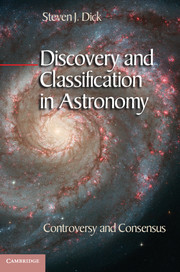Book contents
- Frontmatter
- Contents
- Preface
- Abbreviations
- Introduction The Natural History of the Heavens and the Natural History of Discovery
- Part I Entrée
- Part II Narratives of Discovery
- 2 Moons, Rings, and Asteroids
- 3 In Herschel’s Gardens
- 4 Dwarfs, Giants, and Planets (Again!)
- 5 Galaxies, Quasars, and Clusters
- Part III Patterns of Discovery
- Part IV Drivers of Discovery
- Part V The Synthesis of Discovery
- Appendix 1 Astronomy’s Three Kingdoms
- Appendix 2 Astronomical Discoveries and Their Extended Structure
- Notes
- Select Bibliographical Essay
- Glossary of Concepts Related to Discovery
- Index
5 - Galaxies, Quasars, and Clusters
Discovery in the Realm of the Galaxies
from Part II - Narratives of Discovery
Published online by Cambridge University Press: 05 August 2013
- Frontmatter
- Contents
- Preface
- Abbreviations
- Introduction The Natural History of the Heavens and the Natural History of Discovery
- Part I Entrée
- Part II Narratives of Discovery
- 2 Moons, Rings, and Asteroids
- 3 In Herschel’s Gardens
- 4 Dwarfs, Giants, and Planets (Again!)
- 5 Galaxies, Quasars, and Clusters
- Part III Patterns of Discovery
- Part IV Drivers of Discovery
- Part V The Synthesis of Discovery
- Appendix 1 Astronomy’s Three Kingdoms
- Appendix 2 Astronomical Discoveries and Their Extended Structure
- Notes
- Select Bibliographical Essay
- Glossary of Concepts Related to Discovery
- Index
Summary
It will be at once remarked, that the spiral arrangement so strongly developed in 51 Messier, is traceable, more or less distinctly, in several of the sketches ... we are in the habit of calling all objects spirals in which we have detected a curvilinear arrangement not consisting of regular re-entering curves; it is convenient to class them under a common name, though we have not the means of proving that they are similar systems.
William Parsons, Third Earl of Rosse, 1850Extremely little is known of the nature of nebulae, and no significant classification has yet been suggested; not even a precise definition has been formulated.
Edwin Hubble, 1917It was on February 5, 1963 that the puzzle was suddenly resolved . . . I noticed that four of the six lines exhibited increasing spacing and strength toward the red . . . I started taking the ratio of the wavelength of each line to that of the nearest Balmer line. The first ratio was 1.16, the second 1.16, the third . . . 1.16! . . . Clearly, a redshift of 0.16 explained all the observed emission lines! The extraordinary implications of a “star” of 13th magnitude having a redshift of 0.16 were immediately clear.
Maarten Schmidt, 1983Unlike the realms of the planets and stars, long distinguished by the “wanderers” moving among the fixed stars, the realm of the galaxies had to be discovered. Curiously, however, some of its members had been detected long before they were known to be outside our stellar system. As we saw in Chapter 3, a few objects such as Andromeda and the Magellanic Clouds had long been seen with the naked eye, and in the eighteenth century Charles Messier and William Herschel detected numerous fuzzy objects catalogued as “nebulae.” But these nebulae were largely believed to be in the realm of the stars, as indeed many of them were. How it was determined that some comprised separate systems of stars far beyond our own is a storied part of the history of astronomy, approached in this chapter through the lens of discovery and its complexities. Despite prescient early guesses and some more scientific inferences, it was only Edwin Hubble in the early twentieth century who provided definitive proof that “extragalactic” objects existed beyond our own Milky Way Galaxy.
Information
- Type
- Chapter
- Information
- Discovery and Classification in AstronomyControversy and Consensus, pp. 121 - 170Publisher: Cambridge University PressPrint publication year: 2013
